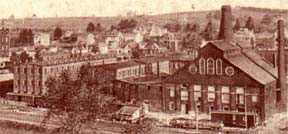Geo. Duncan & Sons (1874 - 1892) glass
factory was founded in 1874 in Southside Pittsburgh and was a partnership
of
George
Duncan,
his
two sons Harry B. and James
E. Sr. and George's son in law Augustus H. Heisey. Their signature
patterns, known by some as "Early Duncan Glassware" include Ribbon,
Three Face, Japanese, Shell & Tassel, Cottage, Ellrose, Zippered Block,
Gonterman, and Snail, but there were many more.
In 1891, the
factory joined the U. S. Glass Co. combine as Factory "D". The
following year, the factory's main building burned down & apparently
some of the molds survived or had already been moved to
other plants incl.to Doyle & Co..
James, Sr. who was initially
the supervisor of Factory D, had left the US Glass Co. in November
of 1891. In 1893, after the 1892 fire, James, his brother Harry & John
Ernest Miller, who had been supervisor of the Pittsburgh Duncan factory
mold shop, opened their own factory
in Washington, PA, about a half hour south of Pittsburgh, forming a
new
partnership
George
Duncan's Sons & Co.
which has also been known as Geo. A. Duncan & Sons (1893
- 1900). Some of their patterns were: Flowered Scroll,
Duncan Flute, Zipper Slash, Grated Diamond & Sunburst,
Paneled Diamond Block, Quartered Block, Diamond Block Band, Tepee,
Scalloped Six-Point, Button Arches, Bassettown, Mardi Gras, Button
Panels & Starred Loop.
After James died
in 1900, John Ernest Miller became
a full partner and the factory became Duncan & Miller (1900
-
1955). Their
patterns include: Diamond Ridge, Block & Rosette, Ladder with Diamonds, Colonial,
Thumbprint Block Band, Clover, Homestead, Sunburst in Oval, and King Arthur
Augustus Heisey, who owned the other
half of Geo. Duncan & Sons (through his wife, Susan Duncan) stayed
with
US
Glass
until
he
left to form Heisey
Glass
Co. in the mid-1890s.
The relationship between these companies has
caused a lot of confusion through the years, but the only connection
was
the involvement
of some
of the same people. Other than the name, the connection between the
original Geo. Duncan & Sons factory and the one that became Duncan & Miller
is exactly the same connection that exists between the original company
and Heisey Glass Co. It can be confusing -- after all, both factories
had similar names, and that wasn't by accident -- when James Duncan
started up the Washington factory, he wanted people to know that he
already had
extensive experience in the glass business. Some of the early
ads make it look like the Washington factory was indeed just a continuation
of the Pittsburgh business. But there was no sharing of patterns,
something
that earlier glass writers didn't always understand. Heacock attributed
some of the Washington patterns to US Glass as a result of the confusion;
although he corrected the error later, you still find it perpetuated
in some books.
|



